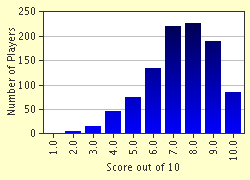Quiz Answer Key and Fun Facts
1. A female sheep is called a:
2. The middle ear in humans contains a chain of three tiny bones one of which is attached to the eardrum. Their names are:
3. Cedar chests are commonly made from the wood of the eastern red cedar. This tree is not a species of the cedar family at all, but is actually:
4. Some boats have special fins that are designed to lift the boat's hull clear of the water at high speeds. This type of fin is called a:
5. All plants and animals must have energy to survive and thrive. The original source of the large majority of this energy is what?
6. Which word is a synonym for the word pusillanimous?
7. The first major antibiotic came into widespread use by the mid 1940's. This antibiotic was:
8. The first member of the deer family to be domesticated is the:
9. The egret is a type of:
10. An insect called the boll weevil is a significant destructive pest on which crop in the United States?
Source: Author
leejo44
This quiz was reviewed by FunTrivia editor
thejazzkickazz before going online.
Any errors found in FunTrivia content are routinely corrected through our feedback system.


